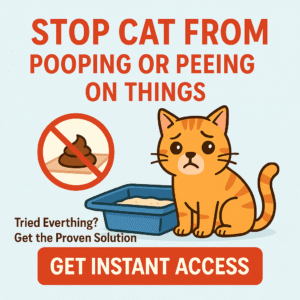Fighting persistent cat urine odor can feel impossible—but it doesn’t have to be. This comprehensive guide shows you how to eliminate cat urine odor permanently by combining proven cleaning methods with behavior solutions that address the root cause.
Why Cat Urine Smells Persist
Cat urine contains uric acid crystals that adhere to surfaces—carpet, rugs, hardwood, concrete, even subflooring. These crystals reactivate when wet, emitting that unmistakable ammonia smell. Most cleaners mask odor temporarily, but only enzyme-based cleaners break down uric acid at a molecular level, truly neutralizing the source.
Essentials You’ll Need
- Paper towels or absorbent cloths
- High-quality enzyme cleaner (e.g., Mister Max Anti Icky Poo, Bubba’s Rowdy Friends, Rocco & Roxie)
- White vinegar, baking soda, hydrogen peroxide, dish soap
- Spray bottles, scrub brushes, wet/dry vacuum
- Black light to detect hidden stains
- Grout sealant or flooring sealant (if applicable)
Step 1: Identify All Affected Areas
Use a UV black light in a dark room to locate all urine spots—they’ll glow yellow-green. Check under furniture, along baseboards, on upholstery, and on flooring. Mark them for treatment.
Step 2: Blot Fresh Urine Immediately
Press down firmly with paper towels—don’t rub, as rubbing can push urine deeper into surfaces. Repeat until no more liquid transfers to the towel.
Step 3: Pre-Treat with Vinegar Solution
Mix equal parts white vinegar and water in a spray bottle. Apply to affected areas and let sit for 10 minutes to neutralize ammonia. Blot dry before applying enzymes.
Step 4: Saturate with Enzyme Cleaner
Enzyme action is essential. Use a trusted enzyme cleaner and fully saturate the area (especially porous surfaces) so enzymes reach deep layers of uric acid crystals. Cover with plastic wrap or a damp cloth to keep it active for at least 12 hours—or overnight for older stains.
- Mister Max Anti Icky Poo: Unscented and professional-strength—great for deep carpet, padding, and subfloor.
- Bubba’s Rowdy Friends Terminator: Mint-eucalyptus scent with Carpet & Rug Institute approval for carpets and upholstery.
- Rocco & Roxie Professional Strength: Proven, CRI-certified enzymatic cleaner for severe or set-in odors.
Step 5: Scrub, Rinse & Extract
After dwell time, scrub the area gently. Use a wet/dry vacuum or absorbent cloths to remove moisture. On hard floors, mop thoroughly with water. This step ensures no enzyme residue or broken-down odor remains.
Step 6: Baking Soda or Hydrogen Peroxide Treatment (if needed)
For stubborn odor, mix 3 tablespoons baking soda, 1 cup of 3% hydrogen peroxide, and a few drops of dish soap. Lightly apply the paste, let it dry, then vacuum or rinse. Always test on a small area first to prevent discoloration.
Step 7: Dry & Final Black Light Check
Allow the area to air dry completely (using fans or open windows). Once dry, scan again with a UV light. If any spots glow, repeat enzyme treatment. The process continues until no glowing areas remain.
Step 8: Seal Floors & Grout (Optional but Recommended)
After cleaning, apply a sealant to carpets, grout, wood, or concrete. This prevents liquids from seeping deep and makes future cleanups easier and more effective.
Step 9: Behavior & Prevention – The Permanent Fix
Clean-up removes the smell—but without behavior correction, your cat may simply repeat the behavior. Persistent marking or accidents often stem from stress, uncertainty, medical issues, or territory control. To prevent recurrence:
- Ensure litter boxes are spotless, accessible, and numerous (1 per cat + 1 extra).
- Reinforce training by rewarding appropriate litter box use—never punish accidents.
- Use pheromone diffusers, quiet spaces, routine feeding, and environmental enrichment.
- If medical issues are suspected (e.g., UTIs, kidney issues), consult your vet promptly.
Step 10: Use a Full Behavior Plan with Cat Spray No More
When deep odor persists or accidents repeat, enzyme cleaning is only part of the solution. Cat Spray No More is a proven eBook program that:
- Helps you understand why your cat is marking or avoiding the litter box
- Guides you through behavior retraining and destressing techniques
- Equips you to set up your home to discourage unwanted elimination
- Ensures lasting success—not just short-term cleanup
Click here to get Cat Spray No More and permanently end accidents—and odors—in your home.
Full Process Summary
| Step | Action |
|---|---|
| 1 | Locate urine spots using UV black light |
| 2 | Blot fresh urine stopping spread |
| 3 | Pre-treat with vinegar solution |
| 4 | Saturate with enzyme cleaner; cover and let sit |
| 5 | Scrub, rinse, extract thoroughly |
| 6 | Apply baking soda/hydrogen peroxide paste if odor persists |
| 7 | Dry completely and re-check with UV light |
| 8 | Seal surface to protect and prevent odors |
| 9 | Fix behavior—improve litter habits and reduce stress |
| 10 | Use Cat Spray No More for a complete behavior plan |
Final Thoughts
Eliminating cat urine odor permanently isn’t a one-off cleanup—it requires targeted cleaners and behavior correction. Use enzyme cleaners to neutralize the source and pair that with the structured behavior solutions in Cat Spray No More. This dual approach helps keep your home clean—and your cat confident and happy.
Take Action & Reclaim Your Home
- Gather your cleaning supplies and enzyme cleaner.
- Follow the full cleaning strategy through to completion.
- Track your cat’s behavior—if marking recurs, use Cat Spray No More to fix it once and for all.
